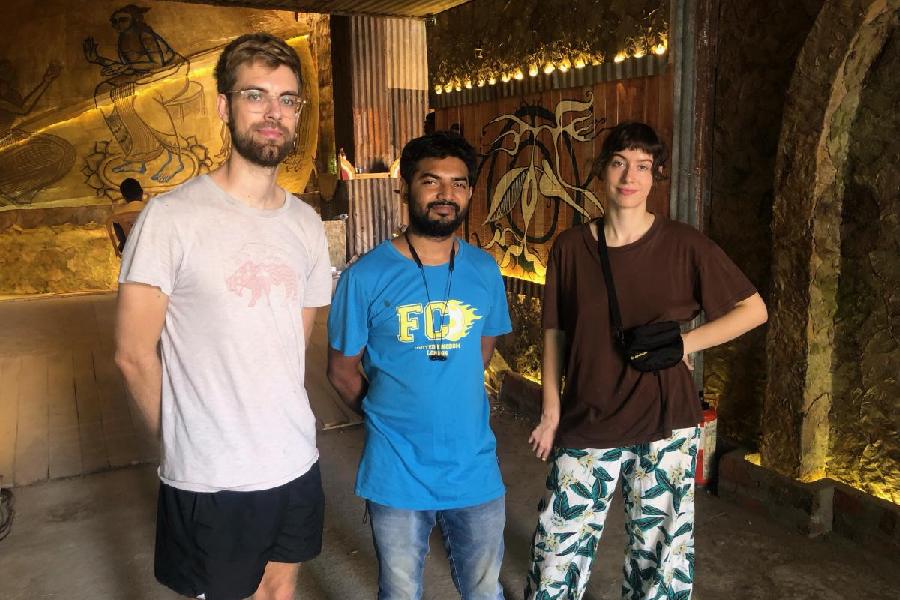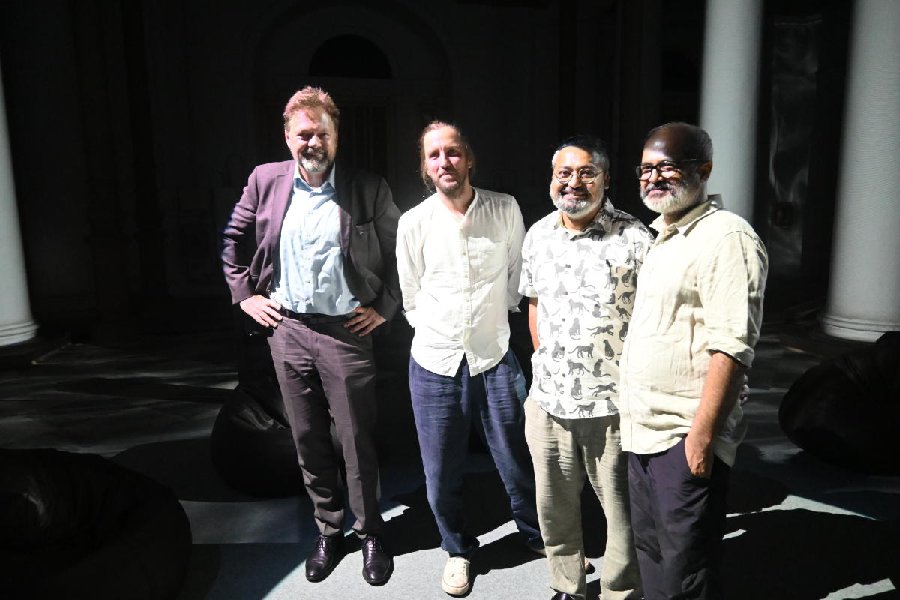The Pujas are over but the flavour of festivity lingers, in the air and in the chatter. Much talk of this pandal and that. Many of you would have seen Behala Nutan Dal’s phuchka-themed Puja with an animation video playing in a loop at the pandal entrance. Then there was the sound installation on display at Calcutta’s Town Hall; it was part of an exhibition on Durga Puja art.
The Pujas are over and now is the time for backstories. Did you know that the phuchka animation, as well as the sound installation, were both products of foreign collaborations?
Well, it is not as if Puja organisers have never sought out artistic talent from abroad. Ten years ago, Hatibagan Nabin Pally got Peshawari truck artists to decorate their pandal, and even before that, Gregor Schneider, one of Germany’s best-known contemporary artists, did an eclectic installation — a vertical road — for Ekdalia Evergreen Club.
But these were one-offs. Non-profit organisation massArt is now actively pursuing the project of taking Durga Puja to the world and forging collaborations between foreign and Indian artists. massArt was formed last year, after Calcutta’s Durga Puja made it into the Unesco representative list of intangible cultural heritage of humanity.
Martyna Pekala and Benjamin Pompe, freshly minted graduates of HKU University of the Arts Utrecht in the Netherlands worked on the phuchka animation video. Thomas Eichhorn, a visual designer from Germany, produced the sound installation.
Sayantan Maitra, who is vice-director of massArt, was instrumental in bringing the Dutch and German artists. He tells The Telegraph, “I know Martijn of Rijksmuseum, who is also an expert in Bengal art. I was in conversation with him on how to bring artists from outside India and expose them to Durga Puja where they can play with materiality, skills and work in this experiential lab. It was he who directed me to HKU University.” Martijn de Rooij is an anthropologist and Indophile and currently associated with the Rijksmuseum in Amsterdam.

Calcutta artist Ayan Saha flanked by Benjamin Pompe and Martyna Pekala of the Netherlands.
Pekala and Pompe were invited to join the Nutan Dal puja in April, after they were selected through a competition. Says Pekala, “We responded to an open call for competition by our teacher at the university. She invited 10 of the alumni, introduced the Durga Puja project and asked us to write a proposal. The two of us together wrote a proposal of a video work, which would be an immersive and natural installation in the pandal. We wanted to make a video about food.” Maitra and Martijn thought Pekala and Pompe would work well with Ayan Saha, the “young artist” working on Nutan Dal’s Durga Puja.
The theme of this particular Puja was tushti or contentment. Saha wanted to project the contentment Calcuttans experience while biting into a tamarind
water-filled phuchka.
Pekala and Pompe, who have been camping in Behala since September, absorbed the sights, sounds of the cityscape. They tasted the illustrious phuchka too. “Very tasty and full of flavour, just as Durga Puja seems to be,” says Pekala. Their animation video, all of one minute and 40 seconds, shows a phuchkawala with his van and enormous box of phuchkas moving across Calcutta. “The techniques and visual style are what we bring from the Netherlands and this we merged with content and presentation that are very local,” she adds.
The challenge for the Dutch duo, who have trained in gallery art and aesthetics, was to make an installation that would appeal to the pandal-hopping crowd and yet be beautiful and aesthetic. According to Pompe, it was a rather delicate project. “There was a lot of pressure to perform and make a spectacle that the crowd would appreciate and enjoy.”
Eichhorn for his part worked with sound artist Sukanta Majumdar on an audio- visual installation titled Jal Katha Bole, which means the waters talk. It was a sensory experience, light telling the audience stories of the rivers Hooghly and Elbe. The rituals of Durga Puja are incomplete without the sacred river waters.
Says Eichhorn, “Our idea was an audio-visual deep dive into the concept of rivers, looking at it from cultural, spiritual and geometric perspectives. We created an audio-visual experience, so people can sit and relax and watch it. The audio talks about the river. The endeavour is to create this space with sounds and the idea of the river visualised geographically. We tried to interpret how you keep interacting with the river, whatever people do there, you sit, listen and learn something and think what the river could mean to you.”
Majumdar, who heads the sound department at Satyajit Ray Film & Television Institute, says, “The challenge was to connect Durga Puja, Germany and water.”
This is not Eichhorn’s first visit to India. As a designer working on media installations and digital experiences, he has conducted multiple projects with Indian artists such as Shilpa Gupta and Asim Waqif in the past and every other year spends a month or two in Delhi or Mumbai. So when massArt invited him to come to Calcutta for the Durga Puja he readily agreed.
He says, “I thought, ‘Why not?’ Durga Puja is not known at all in Germany. It’s kind of weird that such a huge festival is so localised. We have heard of Brahma and Vishnu but not Durga.”
That should begin to change now, courtesy the artavatar.











